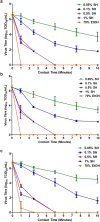The Disinfection Characteristics of Ebola Virus Outbreak Variants
- PMID: 27910909
- PMCID: PMC5133602
- DOI: 10.1038/srep38293
The Disinfection Characteristics of Ebola Virus Outbreak Variants
Abstract
The recent Ebola virus outbreak in West Africa has forced experts to re-evaluate their understanding of how to best disinfect areas contaminated with infectious bodily fluids. Recent research has found that Ebola virus remains viable in blood for 7-10 days making appropriate disinfection crucial to infection control. We sought to determine if the three most important outbreak variants of Zaire ebolavirus (Mayinga, Kikwit and Makona) exhibit separate phenotypes when challenged with a range of sodium hypochlorite (NaOCl) concentrations or 70% ethanol (EtOH) at average West African temperature. The time dependent killing of Ebola virus was evaluated by measuring infectious virus and viral RNA (vRNA), to determine if RNA detection is a viable method for decontamination measurement in areas without high containment laboratory access. Makona was less susceptible to weaker concentrations of NaOCl (0.05 and 0.1%) than Mayinga and Kikwit. At the recommended concentration of NaOCl (≥0.5%) all of the variants were inert after 5 minutes of contact time. Similarly, all variants were inactivated by 70% EtOH after 2.5 minutes, only Makona was detected at 1 minute. In multiple instances, high amounts of vRNA was detected in the absence of infectious virus, suggesting that it does not serve as an accurate measure of remaining infectivity after cleansing.
Figures

 ), 0.1% (
), 0.1% ( ), 0.5% (
), 0.5% ( ) and 1% (x) and 70% ethanol (EtOH) (
) and 1% (x) and 70% ethanol (EtOH) ( ) over time. This amalgamated data is from each disinfectant experiment with virus titres from three independent experiments each with three technical replicates is presented.
) over time. This amalgamated data is from each disinfectant experiment with virus titres from three independent experiments each with three technical replicates is presented.
 ), Kikwit (
), Kikwit ( ) and Makona (
) and Makona ( ) on stainless steel were determined by recovery of infectious particles from the carriers and subsequent quantification using the TCID50 assay performed in quintuplicate for each dilution. Virus titres from three independent experiments each with three technical replicates are presented. For statistical analysis, Makona was compared to Mayinga (green) or Kikwit (blue) at the respective time point.
) on stainless steel were determined by recovery of infectious particles from the carriers and subsequent quantification using the TCID50 assay performed in quintuplicate for each dilution. Virus titres from three independent experiments each with three technical replicates are presented. For statistical analysis, Makona was compared to Mayinga (green) or Kikwit (blue) at the respective time point.
 ) was compared to Mayinga (
) was compared to Mayinga ( ), Kikwit (
), Kikwit ( ) at the respective time point, *p < 0.05, **p < 0.01, ***p < 0.001.
) at the respective time point, *p < 0.05, **p < 0.01, ***p < 0.001.Similar articles
-
Evaluating environmental persistence and disinfection of the Ebola virus Makona variant.Viruses. 2015 Apr 14;7(4):1975-86. doi: 10.3390/v7041975. Viruses. 2015. PMID: 25875372 Free PMC article.
-
Efficacy of microbicides for inactivation of Ebola-Makona virus on a non-porous surface: a targeted hygiene intervention for reducing virus spread.Sci Rep. 2020 Sep 17;10(1):15247. doi: 10.1038/s41598-020-71736-x. Sci Rep. 2020. PMID: 32943689 Free PMC article.
-
Shelf-Life of Chlorine Solutions Recommended in Ebola Virus Disease Response.PLoS One. 2016 May 31;11(5):e0156136. doi: 10.1371/journal.pone.0156136. eCollection 2016. PLoS One. 2016. PMID: 27244552 Free PMC article.
-
General introduction into the Ebola virus biology and disease.Folia Med Cracov. 2014;54(3):57-65. Folia Med Cracov. 2014. PMID: 25694096 Review.
-
Ebolavirus Evolution: Past and Present.PLoS Pathog. 2015 Nov 12;11(11):e1005221. doi: 10.1371/journal.ppat.1005221. eCollection 2015. PLoS Pathog. 2015. PMID: 26562671 Free PMC article. Review.
Cited by
-
Virucidal activity of three standard chemical disinfectants against Ebola virus suspended in tripartite soil and whole blood.Sci Rep. 2023 Sep 21;13(1):15718. doi: 10.1038/s41598-023-42376-8. Sci Rep. 2023. PMID: 37735604 Free PMC article.
-
A systematic review of chlorine-based surface disinfection efficacy to inform recommendations for low-resource outbreak settings.Am J Infect Control. 2021 Jan;49(1):90-103. doi: 10.1016/j.ajic.2020.05.014. Epub 2020 May 19. Am J Infect Control. 2021. PMID: 32442652 Free PMC article.
-
New and emerging infectious diseases (Ebola, Middle Eastern respiratory syndrome coronavirus, carbapenem-resistant Enterobacteriaceae, Candida auris): Focus on environmental survival and germicide susceptibility.Am J Infect Control. 2019 Jun;47S:A29-A38. doi: 10.1016/j.ajic.2019.03.004. Am J Infect Control. 2019. PMID: 31146847 Free PMC article. Review. No abstract available.
-
Challenge of Liquid Stressed Protective Materials and Environmental Persistence of Ebola Virus.Sci Rep. 2017 Jun 29;7(1):4388. doi: 10.1038/s41598-017-04137-2. Sci Rep. 2017. PMID: 28663587 Free PMC article.
-
Combating SARS-CoV-2: leveraging microbicidal experiences with other emerging/re-emerging viruses.PeerJ. 2020 Sep 8;8:e9914. doi: 10.7717/peerj.9914. eCollection 2020. PeerJ. 2020. PMID: 33194365 Free PMC article.
References
-
- (CDC), Centers for Disease Control and Prevention. Outbreaks chronology: Ebola virus disease. 1 (2016). at http://www.cdc.gov/vhf/ebola/outbreaks/history/chronology.html.
-
- (WHO) World Health Organization. Clinical management of patients with viral haemorrhagic fever: a pocket guide for front-line health workers. 1 (2016). at http://www.who.int/csr/resources/publications/clinical-management-patien....
-
- Uyeki T. M. et al.. Ebola Virus Persistence in Semen of Male Survivors. Clin. Infect. Dis. 62, 1552–5 (2016). - PubMed
Publication types
MeSH terms
Substances
Grants and funding
LinkOut - more resources
Full Text Sources
Other Literature Sources
Medical

